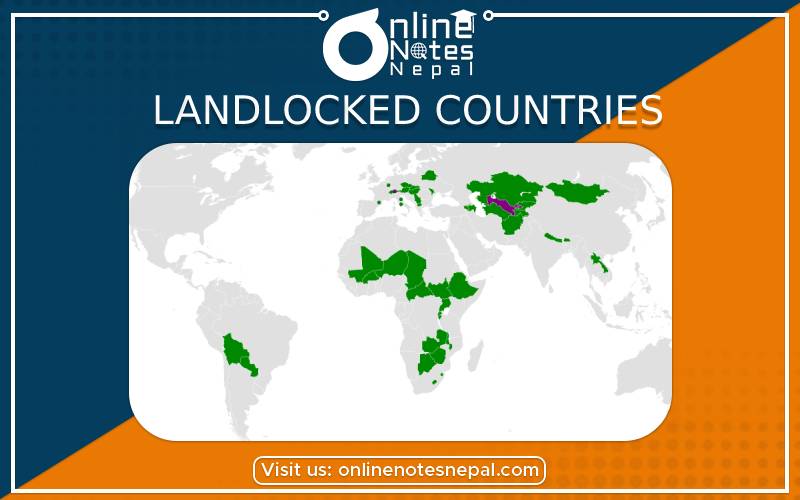Published by: Nuru
Published date: 25 Jan 2022

Landlocked Countries refer to the countries which are locked from other countries by land. Reference notes of Grade 7, Social Studies.
Landlocked Countries
A landlocked country is a state which is entirely surrounded by land. Nepal is a landlocked country. Nepal is situated between two big countries - India and China. It is separated by the Himalayas from China and eastern and western hills and rivers separate Nepal from India. If a country is landlocked, it is likely to be poor due to lack of territorial access to the sea and therefore remoteness and isolation from world markets causing high transit and transportation costs.
These countries are among the poorest of the developing countries. The nearest sea from Nepal is the Bay of Bengal. It is nearly 1126 km away from the eastern border of Nepal. Altogether, there are 44 landlocked countries at present. Kazakhstan is the largest landlocked country in the world. Landlocked countries that attempt to participate in the global economy must contend with the administrative burden of transporting goods through neighboring countries.
There is the highest number of landlocked countries in Europe. There are 32 developing landlocked countries and 12 developed landlocked countries in the world. Lesotho is the only country that is locked in a single country (South Africa).
Here are some of the landlocked countries listed below:
| Asia | Europe | South America | Africa |
| Afghanistan | Austria | Paraguay | Uganda |
| Nepal | Andorra | Bolivia | Chad |
| Armenia-Czech | Macedonia | Zambia | Lesotho |
| Azerbaijan | Vatican city | Zimbabwe | |
| Kirgizstan | Moldova | Niger | |
| Bhutan | Luxemburg | Burkina Faso | |
| Mongolia | Liechtenstein | Burundi | |
| Laos | Switzerland | Botswana | |
| Kazakhstan | Slovakia | Central African Republic | |
| Uzbekistan | San Marino | Malawi | |
| Turkmenistan | Hungary | Mali | |
| Belarus | Ruanda | ||
| Montenegro | Swaziland | ||
| Serbia | Ethiopia | ||
| Total: 12 | Total: 15 | Total: 2 | Total: 15 |
Problems Faced by the Landlocked Countries
Landlocked countries have no territorial access to the seas. Landlocked countries have very often lower average development levels than their neighbors. Those countries which are connected to or near to seas and oceans have developed and progressed. But, landlocked countries not only face the challenge of distance but also, the challenges that result from dependence on passage through a sovereign transit country.
Due to their remoteness, landlocked countries are dependent on neighboring transit countries for their external trades and suffer from high trade transaction costs. The sea is regarded as the storage of minerals and many precious substances. Landlocked countries are at a disadvantage compared with equally remote, island regions of large countries. Landlocked countries like Nepal lack such facilities and access.
Some of the problems faced by Nepal are as follows:
Sea is the source of minerals. These minerals are raw materials for industries. Most of the countries near seas are rich. Tourism can be developed if there is a seashore. Moreover, sea beaches are good tourist destinations. Many European countries have easy access to waterways.
But, landlocked countries like Nepal do not have such access. We have to invest a large amount of capital in roads and airways. Similarly, due to the weak international trade, a landlocked country has to suffer from a frequent price